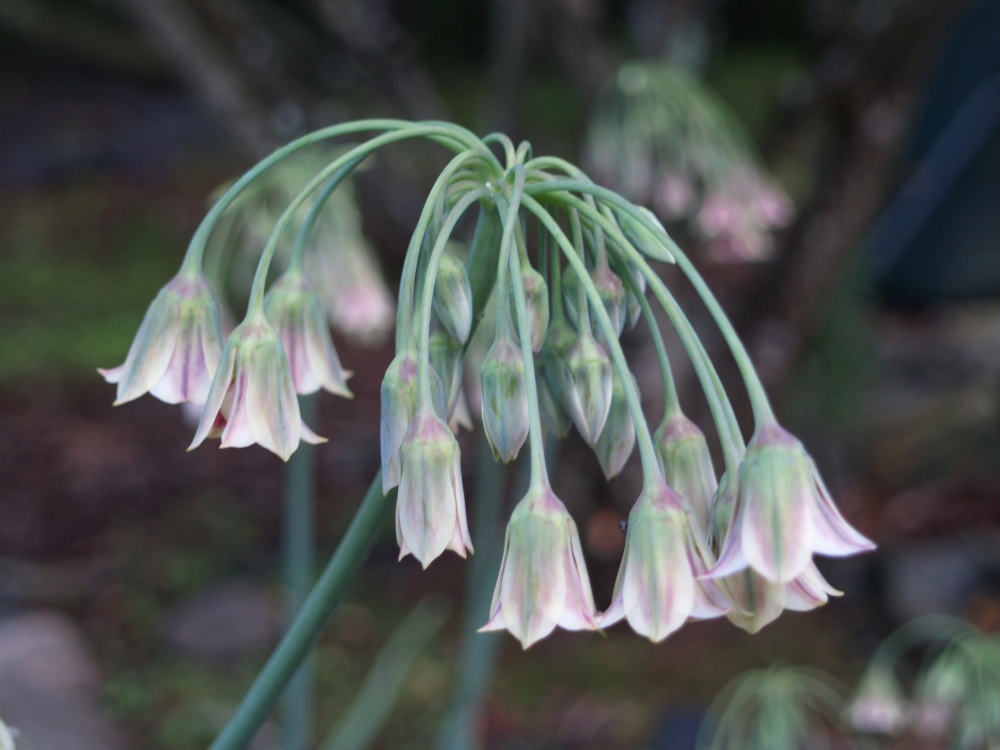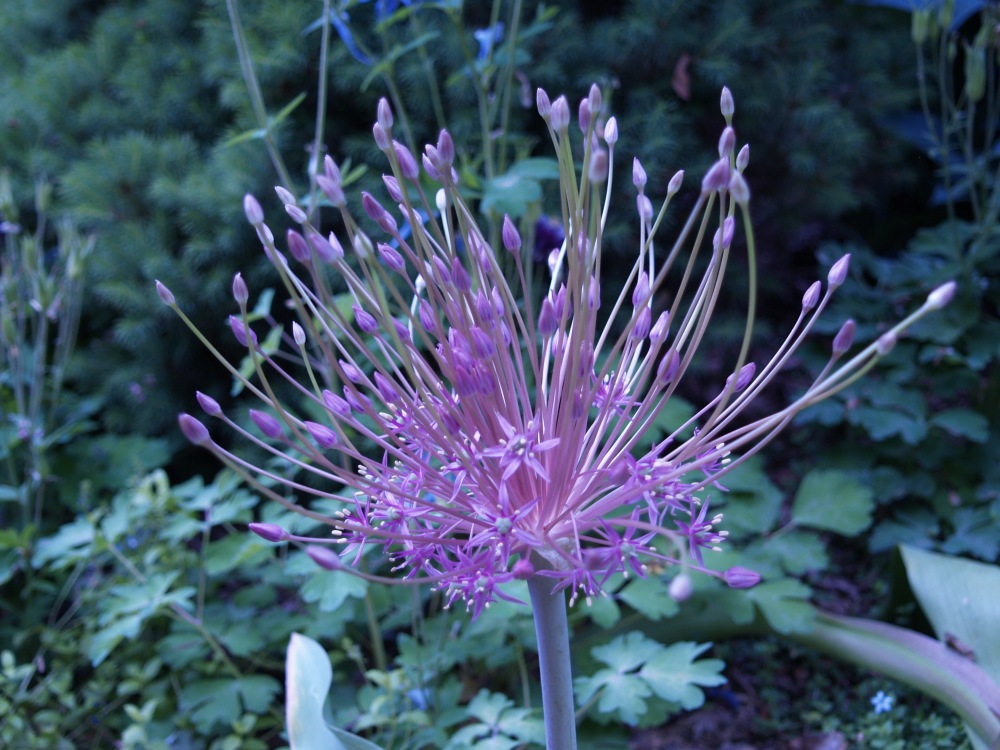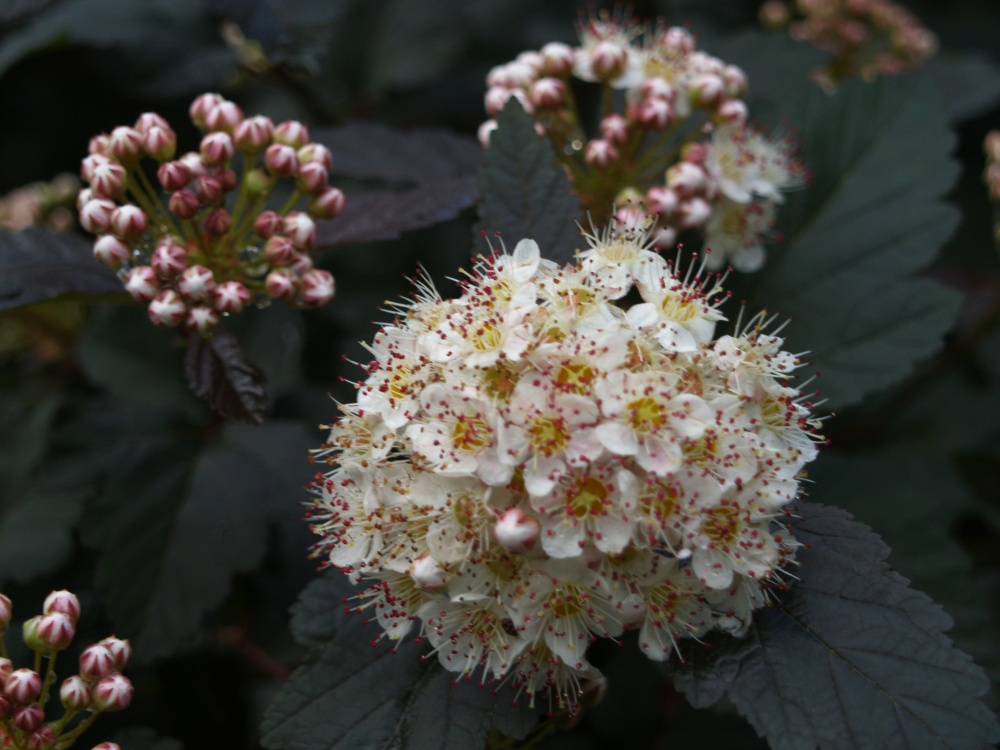Whenever I’m home or working in the garden, I wear a beat up, worn out pair of sandals that probably should have been tossed out long ago. They’re so often covered in mud that I see no reason for a new pair, so I’ll wear them until they disintegrate. My wife cringes whenever I wear them inside, rather than slipping them off outside the door, and I suspect that some day I’ll find that they’ve been put out with the morning’s garbage.
With the persistent rainfall this spring the lawn in the rear garden is so saturated that I can hardly walk around without a sandal being sucked down into the muck. The drier, upper portion of the garden is barely better. But, the plants love it.
Over the past week the waterlogged branches of the ‘Seriyu’ Japanese maples that hover over the front walk have hung so low that the neighbor’s cat couldn’t walk under them, with the branches nearly touching the camassias (Camassia leichtlinii ‘Sacajawea’, above) . The big leafed blue hostas and tall stems of nandinas that border the stone paths are arched and flop about so that you must decide to turn back, or risk getting soaked brushing past them.
There’s been just enough sun and warmth, along with the rain, that the garden is exploding in growth. Yesterday, following one downpour, and with another on the horizon, the garden glowed in the fading light of the evening so that I had to stand and consider that it can’t be any better than this. Other than my soaked feet, that is.
Today, we’ll begin our tour in the low, swampy end of the rear garden and work our way to higher ground over the next few days.
I’ve lost track of the number of flowering onion bulbs that I’ve planted through the years, and I’ve long forgotten or never paid much attention to their names. There are a dozen or more varieties ranging from tiny blooms on eight inch stalks to tall stems with huge globular blooms, and an assortment in between. For the most part they come and go, and they’re pleasant enough for a few weeks while requiring no care, then disappearing until the following year. All are welcomed, but a few stand out as worthy of mention.
Allium bulgaricum (above) and Allium schubertii (below) are notable in a “gee whiz, that’s different” kind of way, and I anxiously await their blooms in mid May. Schubertii is planted in bone dry soil, and bulgaricum is waterlogged in early spring, so you can probably discern that onions are not too picky. I’ve had one of the big globe onions fade away as a tree grew and shade deepened, but in sun or part shade they haven’t a care as to the soil type.
A local garden writer recently stated that the Washington area is too warm for lilacs to bloom dependably, except in isolated, cool micro climates. Perhaps this is true in the city and some of the warmer suburbs, but it will come as a surprise to many area gardeners who relish their lilac’s perfume each May. Indeed, a bit further south there are not enough winter chilling days, and lilacs don’t flower, but I don’t recall hearing of one that hasn’t bloomed around here.
The tall common lilac in my garden was flattened by heavy snow this winter, so I cut it off nearly at ground level. There’s so much else growing around its base that I haven’t noticed if it’s leafing or not, but in case it has decided to call it quits there are three “dwarf” lilacs in the garden that bloom dependably, though they are not very fragrant. Distinguishing a shrub as dwarf is relative to the dimensions of the full sized version, and ‘Miss Kim’ (Syringa patula ‘Miss Kim’, above) is a vigorous and bushy four feet tall and wide. Its habit is quite shrub-like, without the thick woody canes that are typical of the tall, common lilacs. In all, it is a much better behaved shrub, with a long period of bloom and foliage that doesn’t mildew in the summer.
Also along the garden’s northern border is a dark leafed ninebark (Physocarpus opulifolius ‘Diablo’, above) that grows with tall, arching branches so that it appears in need of pruning throughout the year. I haven’t the inclination to keep after it regularly, so I enjoy the May blooms and the almost black foliage, but otherwise ignore its ungainly manner.
A more compact ninebark has recently been introduced, and though I don’t have space enough to plant one unless ‘Diablo’ is removed, it should be a superior shrub and well worth planting.
Now, I’m certain that I’ve tested your patience enough for one day, so we’ll conclude the tour only a third of the way up the slope. Several perennials are blooming around the swimming pond that marks the halfway point of the rear garden, and the roses are popping into bloom, so there I’ll be back in a day or two to continue our journey up the hill to drier ground.
Last year I noticed we had several types of mushrooms & having 2 small puppies, I dug up whatever I found. Some I had to dig into the ground to get what appeared to be “roots”. I have not seen any of these this year.
This year we seem to have just 1-2 varieties but in an enormous amount. Whenever I see the clusters, I pull the heads & stems out. They range from gray to a cream white.
Other than spraying (which I don’t do) is there anything I can do to get rid of these potential poisons to my dogs who love to “mushroom hunt”? With all the rain, it has been hard to mow consistantly. Also, I can’t mow too short because of my terrain.
Hope you have some suggestions! I enjoy your blog & try to read it whenever I can.
Thanks!
Mushrooms are a result of decaying organic material (often mulch) and moisture. If one or both are eliminated then the mushrooms don’t grow. Mulched beds are prime targets since the wood mulch decays. If this is the problem then the drainage must be corrected, though with consistent rainfall this spring there are areas that are wet where drainage would be fine in most years. As summer nears the weather is very likely to be drier, and the problem could be resolved by doing nothing.